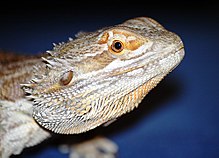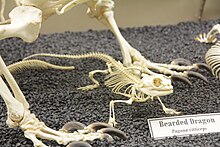| Pogona | |
|---|---|

| |
| Pogona vitticeps | |

| |
| P. vitticeps – detail of head | |
| Scientific classification | |
| Domain: | Eukaryota |
| Kingdom: | Animalia |
| Phylum: | Chordata |
| Class: | Reptilia |
| Order: | Squamata |
| Suborder: | Iguania |
| Family: | Agamidae |
| Subfamily: | Amphibolurinae |
| Genus: | Pogona Storr, 1982[1] |
| Species | |
Pogona is a genus of reptiles containing eight lizard species, which are often known by the common name bearded dragons or informally (especially in Australia) beardies. The name "bearded dragon" refers to the underside of the throat (or "beard") of the lizard, which can turn black and become inflated for a number of reasons, most often as a result of stress, if they feel threatened,[2] or are trying to entice a mate. They are a semiarboreal species, spending significant amounts of time on branches, in bushes, and near human habitation.[3] Pogona species bask on rocks and exposed branches in the mornings and afternoons and sleep at night, making them a diurnal species. Their diet consists primarily of vegetation and some insects. They are found throughout much of Australia and inhabit environments such as deserts, and shrublands.[4]



The genus Pogona is in the subfamily Amphibolurinae of the lizard group Agamidae. Bearded dragons are characterized by their broad, triangular heads, flattened bodies, and rows and clusters of spiny scales covering their entire bodies. When threatened, bearded dragons puff up their bodies and beards to ward off predators and make their somewhat dull spikes seem more dangerous. Bearded dragons display a hand-waving gesture to show submission (most often when acknowledging another bearded dragon's territory), and a head-bobbing display to show dominance[5] between dragons. Some have the ability to slightly change color in response to certain stimuli including rivalry challenges between males and ambient temperature changes (e.g., turning black to absorb heat). Bearded dragons occur in a variety of colors and morphs and can range from being all dark to completely white under controlled breeding conditions. Males grow up to 60 cm (24 in) long, and females up to 51 cm (20 in).
Bearded dragons live in the woodlands, heaths, deserts and coastal dunes,[6] with their range extending throughout the interior of the eastern states to the eastern half of South Australia and southeastern Northern Territory.[7] They are considered to be semiarboreal and quite readily climb and bask at height. This is also linked to dominance behavior and competition for territory/basking areas. They can be found on fallen/broken trees, rocky outcrops, and bushes when basking. Many of the Australian locals have spotted bearded dragons on fence posts and elevated rocky areas. At night, they prefer to dig holes to sleep in, climb in trees, or submerge themselves in rocks and like to climb into the cracks and crevices of stones and caves.[8]
Bearded dragons go through a type of hibernation called brumation, in which like hibernation, reptiles go months without eating, but sporadically drink water. Reptiles go dormant in the hottest temperatures, but it differs from brumation during cooler temperatures. When temperatures are extreme, a very small range of temperatures exists through which the reptile's bodies can stay active and where their bodies cannot tolerate the extreme heat and they die.[9] Bearded dragons go through brumation when the temperature goes below 15.5–21.0°C (60–70°F) during the night and 24.0–26.5°C (75–80°F) during the day for 8-10 hours.[10] When the climate is too hot they will often burrow underground.[11] They will also form more permanent burrows or covered hiding places to use as protection from the climate changes at night and predation.[12]
- ^ Wells, Richard W.; Wellington, C. Ross. 1985. "A Classification of the Reptilia and Amphibia of Australia". Australian J. Herp. Suppl. Ser. (1): 1–61. (Genus Pogona, p. 19).
- ^ "8 Reasons For Your Bearded Dragonś Black Beard". beardeddragontank.com.
- ^ "Housing". Care of Bearded Dragons (Pogona vitticeps). Retrieved 19 December 2019.
- ^ Browne-Cooper, Robert; Brian Bush; Brad Maryan; David Robinson (2007). Reptiles and Frogs in the Bush: Southwestern Australia. University of Western Australia Press. p. 160. ISBN 978-1-920694-74-6.
Pogona minor minor, Abrolhos Bearded Dragon
- ^ Pets, Lizard (23 May 2023). "Why do bearded dragons bob their heads at humans?". Lizard Pets.
- ^ Yang, R.; Brice, B.; Ryan, U. (2016). "Morphological and molecular characterization of Choleoeimeria pogonae n. sp. coccidian parasite (Apicomplexa: Eimeriidae, 1989, Paperna and Landsberg) in a western bearded dragon (Pogona minor minor)". Experimental Parasitology. 160: 11–16. doi:10.1016/j.exppara.2015.11.001. PMID 26586629.
- ^ "Central Bearded Dragon – Pogona vitticeps – Australian Museum". australianmuseum.net.au. Retrieved 19 April 2018.
- ^ "Bearded Dragon (Pogona) Species Profile: Habitat, Diet, and Care". www.peteducation.com. Archived from the original on 29 May 2015. Retrieved 23 September 2015.
- ^ Mayer, William Vernon. “Dormancy.” Encyclopædia Britannica, Encyclopædia Britannica, Inc., 17 May 2016, www.britannica.com/science/dormancy#ref1121981.
- ^ Vosjoli, Philippe De. The Bearded Dragon Manual: Expert Advice for Keeping and Caring for a Healthy Bearded Dragon. 2nd ed., Lumina Media, 2016.
- ^ "Why Do Bearded Dragons Burrow? – Online Bearded Dragon Care". 21 September 2015. Retrieved 23 September 2015.
- ^ Doneley, Bob. "CARING FOR THE BEARDED DRAGON" (PDF). Exotics — Reptiles and Amphibians.